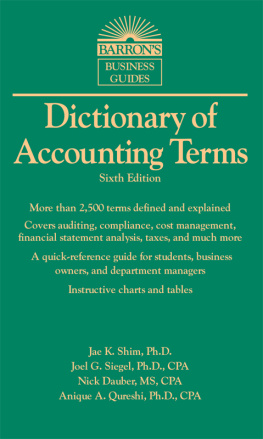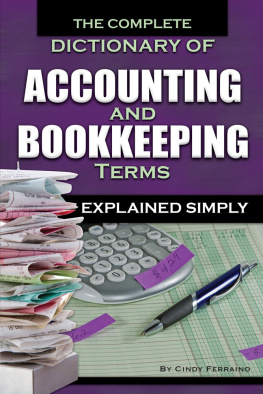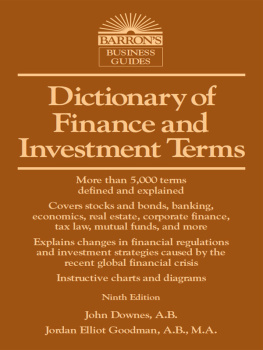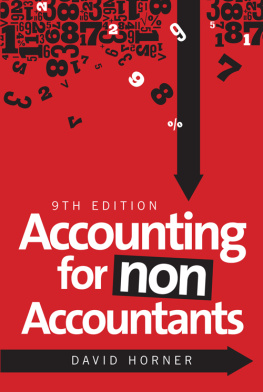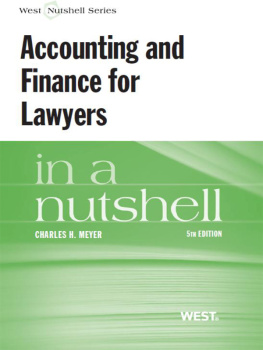Dictionary of Accounting Terms
Sixth Edition
Jae K. Shim, Ph.D.
Former Professor of Accounting
College of Business Administration
California State University, Long Beach
Joel G. Siegel, Ph.D., CPA
Professor of Accounting
Queens College of the City University of New York
Nick Dauber, MS, CPA
Lecturer in Accounting
Queens College of the City University of New York
Anique A. Qureshi, Ph.D., CPA
Professor of Accounting and Information Systems
Queens College of the City University of New York

ACKNOWLEDGMENTS
The authors would like to acknowledge the contributions made by reviewers John Downes, formerly of the New York City Office of Economic Development, and Dr. G. Thomas Friedlob, Professor of Accounting at Clemson University. Their in-depth evaluations have been of great importance to the technical accuracy of the manuscript. Gerald J. Barry suggested many meaningful insertions and deletions that greatly enhanced the authors prose. Thanks also go to Roberta Siegel, Allison Shim, University of California at Irvine, Oleksiy Y. Duplinskyy and Therese Dayvit, both from California State University, Long Beach, and Dr. Qianyun Ivy Huang, Assistant Professor of Accounting at Queens College of the City University of New York, for their assistance with the computer terms, graphics, and word processing. Anna Damaskos, Don Reis, Sally Strauss, and Eileen Prigge of Barrons have been invaluable during the many stages of editing the manuscript into its bound book form.
Copyright 2014, 2010, 2005, 2000, 1995, 1987 by Barrons Educational Series, Inc.
All rights reserved.
No part of this publication may be reproduced in any form or by any means without the written permission of the copyright owner.
Barrons books are available at special quantity discounts to use as premiums and sales promotions, or for use in corporate training programs. For more information, please write to the Special Sales Manager, Barrons Educational Series, Inc. at the mailing address indicated below.
All inquiries should be addressed to:
Barrons Educational Series, Inc.
250 Wireless Boulevard
Hauppauge, NY 11788
www.barronseduc.com
eISBN: 978-1-4380-9246-1
Please be advised that certain pages, illustrations, tables, graphs, etc. may look different depending on what type of device you are using to view this eBook on. Please adjust your device accordingly.
CONTENTS
Whether you audit the records of a large corporation or balance your own checkbook, you will find Barrons Dictionary of Accounting Terms of immeasurable help. You may be a business persona bookkeeper, a manager, or a proprietor. You may be a business studentan accounting major or an MBA candidate. You may be an accountant or you may have to deal with accountants. Whatever the case, this Dictionary provides the definitions, examples, and illustrations you need to know about all aspects of financial record keeping.
In class or at a business meeting, you are likely to hear an accounting term that is unfamiliar to you. You need to know what that term means and its application in order to follow the presentation intelligently. At home you may be puzzled by a reference in a text you are studying or by a direction in a form you are completing. You need to understand what is meant in order to proceed with the task efficiently. Keeping a copy of this volume by your side will provide the explanations and demonstrations that will enable you to handle all of these problems.
Accounting is a dynamic area with a vocabulary that is constantly changing. To talk its language, you have to keep up-to-date with the latest terms that have just emerged and with the latest definitions of older terms. It is this books purpose to present the working vocabulary of accounting todaydefining new terminology as it affects the accounting profession, while updating the traditional language of accounting and its related disciplines.
Entries have been drawn from all areas within accounting including financial accounting, managerial and cost accounting, auditing, financial statement analysis, and taxes. Definitions have also been provided for many terms from related business disciplines that the accountant must know about in order to perform his or her functions in the business world. Included are essential words from finance, international accounting, quantitative techniques, information technology and the Internet, and economics. In all, clear, concise definitions are provided for more than 2500 terms, and a further explanation of the term or a demonstration of its use is frequently given to amplify the definition. Thus, each entry is basic enough for the novice to grasp the essential meaning quickly, yet comprehensive enough for the professional to find additional detail when it is needed.
The authors sincerely hope that this dictionary will prove a handy reference for anyone involved with accountingfrom the layman to the expert.
Jae K. Shim
Joel G. Siegel
Nick Dauber
Anique A. Qureshi
Alphabetization: All entries are alphabetized by letter rather than by word, so that multiple-word terms are treated as single words. For example, .
Many words have distinctly different meanings, depending upon the context in which they are used. The various meanings of a term are listed by numerical or functional subheading. Readers must determine the context that is relevant to their purpose.
When terms are defined as different parts of speech, the grammatical forms are not labeled but the sequence is always nouns, followed by verbs, followed by qualifiers.
Abbreviations: A separate list of Abbreviations follows the Dictionary.
Cross-References: To add to your understanding of a term, related or contrasting terms are sometimes cross-referenced. The cross-referenced term will appear in SMALL CAPITALS either in the body of the entry (or subentry) or at the end. These terms will be printed in SMALL CAPITALS only the first time they appear in the text. Where an entry is fully defined by another term, a reference rather than a definition is providedfor example: .
Italics: Italic type is generally used to indicate that another term has a meaning identical or very closely related to that of the entry. Italic type is also used to highlight the fact that a word or phrase has a special meaning to the trade. Italics are also used for the titles of publications.
Parentheses: Parentheses are used in entry titles to indicate that an abbreviation is used with about the same frequency as the term itself; for example, .
Special Definitions: Organizations and associations that play an active role in the field are included in the Dictionary along with a brief statement of their mission.
ABACUS
instrument of ancient origin used to perform arithmetic calculations by sliding counters along rods or in grooves.
semiannual accounting research journal (founded in 1965) published by the Sydney University Press, edited by the University of Sydney, Department of Accounting. The subject matter covers all areas of accounting including international accounting.
ABANDONMENT voluntary surrender of property, owned or leased, without naming a successor as owner or tenant. The property will generally revert to a person holding a prior interest or, in cases where no owner is apparent, to the state.
ABATEMENT complete or partial cancellation of a levy imposed by a governmental unit. Abatements usually apply to tax levies, special assessments, and service charges.
ABCsee .
ABC METHOD
Next page
